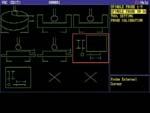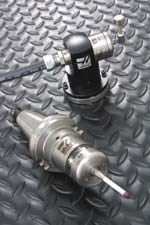System Simplifies Probing Operations On VMCs
Few machinists will dispute the merits of probing for speeding part setup, setting tool offsets and performing in-process inspection . . . at least in theory. In practice, however, probe systems often have been viewed as difficult to use and expensive to buy.
Few machinists will dispute the merits of probing for speeding part setup, setting tool offsets and performing in-process inspection . . . at least in theory. In practice, however, probe systems often have been viewed as difficult to use and expensive to buy. As a result, they've become tools used primarily by experienced programmers in high-production environments.
The Visual Quick Code probing system from Haas Automation, Inc. (Oxnard, California) is designed to make probing effective and more affordable to a wide range of users. The system was recently developed in conjunction with Renishaw, a leader in probe systems.
Available as an option on new Haas vertical machining centers, the system consists of a spindle probe, a contact tool setting probe, an optical receiver and Renishaw's Inspection Plus software. The system is installed and calibrated at the machine tool builder's factory.
The system features a conversational programming system that uses a graphical interface and a question/answer format to create G-code programs. It does not require knowledge of macro programming. The machinist creates probe routines for tool setting and part setup by entering basic information with the keyboard on the CNC.
For example, to probe the external corner of a workpiece and establish a work offset, the machinist selects the appropriate graphical template, jogs the spindle probe to within 0.5 inch of the selected corner and enters the following information: work offset number (for example, G54), approximate X width of the material, approximate Y width of the material and which corner to probe. Once this information is entered, a pop-up dialog box prompts the machinist to choose where to output the G code: to a new program, to an existing program or directly to manual data input (MDI). Once a destination is selected, the G code is generated automatically for the probe routine.
If the G code is used as direct data input, the machinist hits Cycle Start to probe the workpiece and automatically enter the correct offsets into the control. If the machinist chooses to create a new program, the program can be called up immediately to start the probe routine, or saved for later use. If the G code is inserted into an existing part program, it can be used to probe each workpiece and update the offsets prior to machining.
The system also has templates for finding the center of a workpiece, probing a bore or boss, measuring bore-to-bore or boss-to-boss and probing a web or pocket.
The procedure for setting tool offsets follows a pattern very similar to the procedure for setting work offsets, with templates for automatically measuring tool length, tool diameter or both. The machinist can measure tools individually or create a probe routine to check a carousel of tools.
The company points out that despite the very favorable pricing, the system is considered a full-featured, high-resolution probe system capable of many other probing tasks in addition to tool and part setting. Using macros (included) and advanced programming methods, it can perform such operations as in-process tool and part inspection, first-off part measurement, automatic compensation for thermal changes and checking for worn or broken tools. This functionality reduces operator-induced variations in the process and builds confidence in unattended machining processes.
Related Content
Additive/Subtractive Hybrid CNC Machine Tools Continue to Make Gains (Includes Video)
The hybrid machine tool is an idea that continues to advance. Two important developments of recent years expand the possibilities for this platform.
Read More6 Machine Shop Essentials to Stay Competitive
If you want to streamline production and be competitive in the industry, you will need far more than a standard three-axis CNC mill or two-axis CNC lathe and a few measuring tools.
Read MoreHigh RPM Spindles: 5 Advantages for 5-axis CNC Machines
Explore five crucial ways equipping 5-axis CNC machines with Air Turbine Spindles® can achieve the speeds necessary to overcome manufacturing challenges.
Read MoreLean Approach to Automated Machine Tending Delivers Quicker Paths to Success
Almost any shop can automate at least some of its production, even in low-volume, high-mix applications. The key to getting started is finding the simplest solutions that fit your requirements. It helps to work with an automation partner that understands your needs.
Read MoreRead Next
5 Rules of Thumb for Buying CNC Machine Tools
Use these tips to carefully plan your machine tool purchases and to avoid regretting your decision later.
Read MoreThe Future of High Feed Milling in Modern Manufacturing
Achieve higher metal removal rates and enhanced predictability with ISCAR’s advanced high-feed milling tools — optimized for today’s competitive global market.
Read MoreRego-Fix’s Center for Machining Excellence Promotes Collaboration
The new space includes a showroom, office spaces and an auditorium that will enhance its work with its technical partners.
Read More


















.jpg;maxWidth=300;quality=90)








